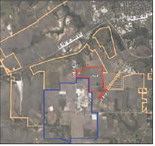Residents weigh concerns about a second project coming to Taylor
The City Council next month could vote on a zoning request for a new data center near Samsung Austin Semiconductor, though critics are voicing worries similar to those about a controversial site underway on the South Side.
The Planning & Zoning Commission Wednesday did not have a quorum to recommend approval of the request by Dallas-based KDC developers for an employment center dubbed “Project Comal,” planned for a 210acre lot at 1051 CR 401 next to Samsung.
The council has the final say in zoning requests whether they are approved or not by the commission, officials said.
“Either way, council will consider this on Dec. 11 and I’d encourage them to understand the full environmental, energy, water and ratepayer impacts this will have on the community before voting to approve,” P&Z Chairwoman Amy Everhart noted in an online post after the meeting.
During Wednesday’s session and public hearing, some P&Z commissioners and speakers aired concerns about the impact data centers have on communities.
Fresh on the minds of many residents is the recent controversy over the establishment of Blueprint Data Centers, a $1 billion project at 1601 E. Martin Luther King Jr. Blvd. that recently was allowed to proceed after a state district judge lifted an injunction.
Regarding Project Comal, a portion of the rural land recently was annexed into by city and the applicant will be asking the council to annex an additional adjoining parcel they recently acquired, a representative for the developer said.
The resolution Wednesday was a request to have the zoning changed to “employment center.”
Some P&Z commissioners indicated more clarity is needed for the term “employment center.”
“As a commissioner, I have a problem with the definition we have in our city of what an employment center is because an employment center to me would bring in jobs in a large quantity,” said Commissioner Barbara Aviles-Torsberg. “And in this case, that’s an awful lot of land and a lot of commitment of energy and infrastructure for a potential of very few jobs.”
Data centers can temporarily employ hundreds during construction, but afterwards it only takes a handful of employees to run the site.
Residents who spoke Wednesday worried about noise, water and energy usage and eminent domain for utility and roadways.
David Fisk, executive vice president of KDC, did not identify a specific tenant, but told the audience using eminent domain to acquire right of ways is not in the plans.
He added electricity would originate from the same substation supplying Samsung, which is expected to be operational late next year.
He also indicated the data-center tenant would minimize water usage.
“We would assume that the tenants for this project would either use a closed-water system that uses water filling up the system once and doesn’t continue to use public water. That is our preference,” Fisk said. “There are other systems that use lots and lots of potable water. We’re not fans of those in particular.”
Though he said he felt confident the data center would comply with local regulations, others at the meeting said they aren’t so sure.
Carrie D’Anna, who has been instrumental in supporting the fight against the Blueprint Data Centers development, is apprehensive about a new data center being proposed next to her own District 1 neighborhood.
“We are approaching a time in our area when this industry is flooding in. This is only our second data center but it won’t be our last. And our zoning and the way that we look at it, I feel that we are really illequipped and ill-educated on what questions to ask,” D’Anna said. “The industry has not been around long enough for us to really understand how it will affect us.”
As Central Texas becomes a high-tech hub for global businesses, more data centers are emerging in the area, including Georgetown.
Project Comal has requested a permit to use 360 megawatts of energy. Everhart, who works for Austin Energy, noted Austin uses 3,000 megawatts daily.
She said the proposed Taylor data center could potentially use more than 10% of the energy required by the entire city of Austin each day.
“You said that ratepayers will not be impacted because the cost is borne by the site, but transmission costs to get power from power plants to a substation are socialized across (the Electric Reliability Council of Texas) so everybody who pays an energy bill will pay for that,” Everhart said to company representatives.
She added, “As we bring in more power to Taylor in general we are all paying higher bills including for the new lines that are being built on North Main (Street) and east of town as well.”

This illustration shows the Project Comal site in red, next to the Samsung Austin Semiconductor fabrication plant outlined in blue. The orange lines indicate Taylor’s city limits. Courtesy of the Planning & Zoning Commission








